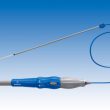This new meta-analysis did not manage to prove whether permanent pacemaker implantation after transcatheter aortic valve replacement (TAVR) raises the rates of mortality, infarction, or stroke. Implantation could only be associated to a lesser recovery of ventricular function after the procedure, something that had already been observed in previous studies. Patients who required a pacemaker undoubtedly...
“Ad Hoc” PCI during TAVR: No Impact on Safety or Long Term Outcomes
According to a recent study published in Circulation Cardiovascular Interventions, screening for coronary artery disease (CAD) with an invasive coronary angiography (as part of the protocol prior TAVR) and performing PCI and TAVR in the same session, has no impact on periprocedural safety or on long term outcomes. Study outcomes offer new hope, especially as regards using TAVR...
VALIDATE-SWEDEHEART: bivalirudin seems to be losing ground
Another important work that does not see the benefits of bivalirudin over heparin as monotherapy as regards both efficacy (death and MI) and safety end points (bleeding) in patients undergoing acute myocardial infarction with and without ST elevation. The study VALIDATE-SWEDEHEART, presented at ESC, simultaneously published in the New England Journal of Medicine, randomized 6000 patients...
Dual antiplatelet therapy discontinuation causes more thrombotic events at 12 months
Several randomized studies have shown that dual antiplatelet therapy (DAPT) is as effective to prevent thrombotic events in the segment treated with PCI, as it is with the rest of the coronary segments. This is very clear. The problem is there are a series of adverse events following P2Y12 inhibitor discontinuation. This phenomenon called rebound effect, happens...
Early Invasive Strategy Benefits High-Risk Patients
Early angiography is not associated with a reduction in mortality compared with a more delayed invasive strategy in patients with non-ST-elevation acute coronary syndrome (NSTE-ACS). However, a new meta-analysis published by The Lancet supports the idea that certain high-risk patients would benefit from it. Patients with elevated cardiac biomarkers, a high GRACE score, diabetes, or advanced...
Striking Finding on Diabetes and Bypass Graft Patency
The higher rate of restenosis in the diabetic population is historic and has been reproduced in all studies and with all kinds of stents, but it was only after the FREEDOM trial when we found out about the higher infarction rate with PCI compared to surgery. This is why 50% of patients undergoing CABG are diabetic. Apart from the above...
Positive Outcomes of CoreValve Evolut in Large Population
The Evolut R, as well as its predecessor the CoreValve, is a self-expandable valve, supra-annular, made of porcine pericardium in a nitinol frame. Amongst its improvements, it has a better profile and the option to resheath. This makes it fully repositionable and even recapturable. We only needed to confirm these technical advantages would translate into clinical...
Should We Begin to Use IVUS in CTO?
Courtesy of Dr. Carlos Fava. Currently, chronic total occlusions (CTO) are one of the obstacles that coronary angioplasties must overcome, particularly with the development of drug-eluting stents (DES) and new devices and strategies for these challenging lesions. However, there is little information on the safety, efficacy, and real clinical benefit of implanting stents of over 60 mm (known as full metal jackets, FMJ)....
2 Year Outcomes of Lutonix Drug Coated Balloon in Superficial Femoral Arteries
There are plenty of clinical studies assessing the use of angioplasty for en la peripheral artery disease with restenosis rates as high as 40% and 60% at 6 and 12 months. Drug coated balloons have significantly raised primary patency, but they have mostly been tested in short lesions with mild calcification and no total occlusions. This...
Bleeding and Mortality in Transcatheter Aortic Valve Replacement
Transcatheter aortic valve replacement (TAVR) is much less invasive than surgical replacement. This is associated with a substantial reduction in bleeding events (up to 60% less). However, clinically relevant bleeding is still present in one every four patients who undergo TAVR, which is associated with morbidity and mortality. Cases of bleeding are not uniform: they may...









